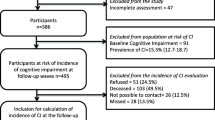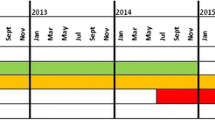Abstract
This paper describes the design and first results of the cross-sectional phase of a study on memory impairment in elderly subjects (Pavia Memory Project). The target population consisted of the 1,046 subjects born in 1925 and currently living in Pavia. Four hundred and thirty-six subjects (plus 287 interviewed at home) participated in the first stage, which consisted of a semistructured anamnestic interview. The 400 interviewed subjects with none of the exclusion criteria participated in the second stage, which consisted of a memory test battery, a standardized neurological examination and screening procedures for depression (GDS) and dementia (MMSE). On the basis of the memory scores, three groups were defined: memory impairment (MI: 8.8%), mild memory impairment (MMI: 39.8%); normal (N: 51.3%). There were more failures on the visuo-spatial memory tests. Depression was equally distributed in the N and MI groups (about 15%), but was more frequent in the MMI group (27%). Abnormal neurological signs were largely independent of memory performance. Two cohorts (of MI and N subjects) underwent neuropsychological and instrumental (CT-scan, EEG, ERPs, eye movements) assessment, which will be regularly repeated in the longitudinal phase.
Sommario
Viene presentato il disegno di uno studio sui disturbi mnesici del soggetto anziano (Progetto Pavia Memoria) e vengono riportati i primi risultati relativi alla fase trasversale. La popolazione in studio era rappresentata dai 1046 soggetti nati nel 1925 e residenti a Pavia. 436 soggetti (più 287 intervistati a domicilio) hanno partecipato al primo stadio che consisteva in una intervista semistrutturata per la raccolta di dati anamnestici. 400 soggetti che non presentavano criteri di esclusione hanno partecipato al secondo stadio che consisteva in una batteria di test di memoria, in un esame neurologico standardizzato e in procedure di screening per la depressione (GDS) e la demenza (MMSE). Sulla base dei punteggi ottenuti ai test mnesici sono stati definiti tre gruppi di soggetti: disturbo mnesico (MI: 8.8%); disturbo mnesico lieve (MMI: 39.8%) e normali (N: 51.3%). I test di memoria visuo-spaziale sono risultati alterati con maggiore frequenza. La depressione era ugualmente distribuita nei gruppi MI e N (circa 15%), ma era più frequente nel gruppo MMI. La presenza di segni patologici all'esame neurologico era per lo più indipendente dalle prestazioni mnesiche.
Due coorti (di soggetti MI e N) sono state sottoposte a valutazioni neuropsicologiche e strumentali (TC, EEG, potenziali evento-correlati, movimenti oculari) che verranno ripetute a regolari intervalli nella fase longitudinale.
Similar content being viewed by others

References
Blackford R.C., La Rue A.:Criteria for diagnosing AAMI: proposed improvement from the field. Develop. Neuropsychol. 5:295–306, 1989.
Botwinick J.:Intellectual abilities. In J.E. Birren and K.W. Schaie (Eds.):Handbook of the psychology of aging. Van Nostrand Reinhold, New York, 1977.
Capitani E., Laiacona M., Ciceri E. et al. (Gruppo di studio per lo studio neuropsicologico dell'invecchiamento):Sex differences in spatial memory: a reanalysis of block tapping long-term memory according to the short-term memory level. Ital. J. Neurol. Sci. 12:461–466, 1991.
Cipolli C., Andermarcher E., Pinelli M., Neri M.:Relazioni tra misure soggettive e oggettive della memoria nell'anziano. In: D. Salmaso and P. Caffarra (Eds):Normalità e patologia delle funzioni cognitive nell'invecchiamento. Angeli, Milano, pp. 86–92, 1990.
Cohen J.:Weighted kappa: Nominal scale agreement with provision for scale disagreement of partial credit. Psychol. Bull. 70:213–220, 1968.
Cosi V., Romani A.:The neurological examination in the normal elderly: prevalence of “abnormal” signs and relations to memory disturbances. XXVIII National Congress of the Italian Neurological Society, Firenze, Abstract p. 91, 1993.
Crook T., Bartus R.T., Ferris S.H. et al.:Age-associated memory impairment; proposed diagnostic criteria and measures of clinical change. Report of a NIMH work group. Dev. Neuropsychol. 2:261–276, 1986.
Derouesne C., Kalafat M., Malbezin M., Poilrenaud J.:The construct of “Age-Associated Memory Impairment” (AAMI) revisited. Report of a French-speaking work group. Int. J. Geriat. Psychiatr. 9:577–586, 1994.
Fletcher W.A., Sharpe J.A.:Saccadic eye dysfunction in Alzheimer's disease. Ann. Neurol. 34:464–471, 1986.
Fletcher W.A.:Smooth pursuit dysfunction in Alzheimer's disease. Neurology 38:272–277, 1988.
Folstein M.F., Folstein S.E., McHugh P.R.:Mini-mental State: a practical method for grading the cognitive state of patients. J. Psychiatr. Res. 12:189–198, 1975.
Gado M., Duziger W.L., Chi D. et al.:Brain parenchymal density measurements by CT in demented subjects and normal controls. Radiology 147:703–710, 1983.
Gomori J.M., Steiner I., Melamed E. et al.:The assessment of changes in brain volume using combined linear measurements: a CT scan study. Neuroradiology 26:21–24, 1984.
Huff J.F., Boller F., Lucchelli F., Querriera R., Beyer J., Belle S.:The neurological examination in patients with probable Alzheimer's disease. Arch. Neurol. 44:929–932, 1987.
Jenkin L.R., Reeves A., Warren T. et al.:Neurologic signs in senescence. Arch. Neurol. 42:1154–1157, 1985.
Kral V.A.:Benign senescent forgetfulness. Aging 7:47–51, 1978.
Mauguiere F.:Electro-encephalographie et potentiels evoques. In: J.L. Signoret and J.J. Hauw (Eds),Maladie d'Alzheimer et autres demences. Flammarion, Paris, pp. 39–49, 1991.
Novelli G., Papagno L., Capitani E., Laiacona M., Vallar G., Cappa S.F.:Tre test clinici di ricerca e produzione lessicale. Taratura su soggetti normali. Archivio di Psicologia, Neurologia e Psichiatria XLVII: 477–506, 1986.
Orsini A., Grossi D., Capitani E., Laiacona M., Papagno C., Vallar G.:Verbal and spatial immediate memory span: normative data from 1355 adults and 1112 children. Ital. J. Neurol. Sci. 8: 539–548, 1987.
Polich J., Ladish C., Bloom F.E.:P300 in early Alzheimer's disease. Electroenceph. Clin. Neurophisiol. 77:179–189, 1990.
Rae-Grant A., Blume W., Lau C., Hachinski V.C., Fisman M., Merskey H.:The electroencephalogram in Alzheimer-type dementia. A sequential study correlating the electroencephalogram with psychometric and quantitative pathologic data. Arch. Neurol. 44, 50–54, 1987.
Ratti M.T.:Valutazioni soggettive e oggettive della memoria in adulti e anziani. Psicologia e Società XVII: 129–151, 1992.
Ratti M.T., Amoretti G.:Le funzioni cognitive nella terza età. Nuova Italia Scientifica, Roma, 1991.
Romani A., Cosi V., Zerbi F., Gozzoli L.:Correlati clinici e tomodensitometrici dell'incremento di latenza della P300 in pazienti dementi. Atti 13ma riunione LIMPE, Guanella, Roma: 182–194, 1987.
Rosen T.S.:“Age-associated memory impairment”: a critique. Europ. J. Gen. Psych. 2:275–287, 1990.
Sandor T., Albert M., Stafford J.:Use of computerized CT analysis to discriminate between Alzheimer patients and normal control subjects. Am. J. Neuroradiol. 9:1181–1187, 1988.
Spinnler H., Tognoni G.:Standardizzazione e taratura italiana di test neuropsicologici. Ital. J. Neurol. Sci. 8; (suppl. 8), 1987.
Tulving E.:Episodic and semantic memory. In E. Tulving, W. Donaldson (Eds).Organization of memory. Academic Press, New York, 381–403, 1972.
Yesavage J.A., Brink T.L., Rose T.L., Lum O., Huang V., Adey M., Leirer V.O.:Development and validation of a geriatric depression scale: a preliminary report. J. Psychiat. Res. 17, 1:37–49, 1983.
Author information
Authors and Affiliations
Rights and permissions
About this article
Cite this article
Cosi, V., Citterio, A., Ratti, M.T. et al. Pavia Memory Project: Study design and first results. Ital J Neuro Sci 16, 141–148 (1995). https://doi.org/10.1007/BF02282980
Received:
Accepted:
Issue Date:
DOI: https://doi.org/10.1007/BF02282980



